Statement Earrings With Beads – Quick and Easy For How to Make Statement Earrings
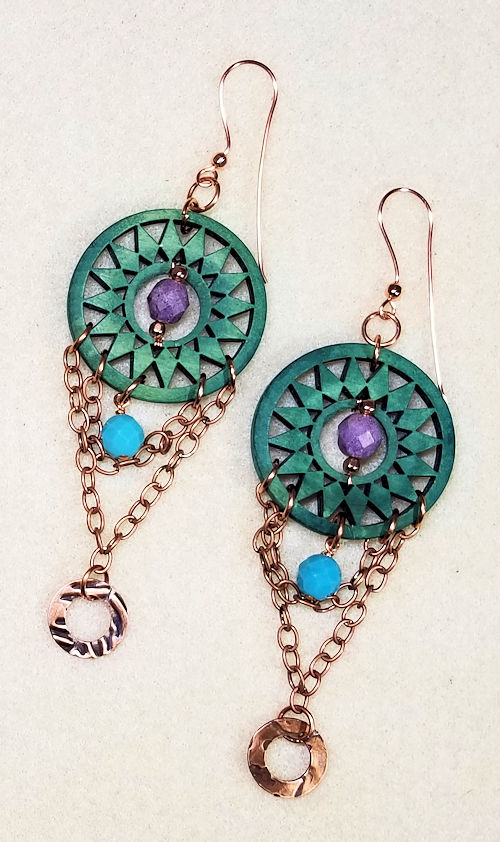
How to Make Statement Earrings? Watch the video – it’s easier than you might think!
Statement Earrings with beads are big these days – literally and figuratively! And as to how to make statement earrings? They are easier to make than you think – and you may have all the supplies you need right in your jewelry-making stash! These earrings are suitable for beginning and experienced beaders alike; the most important supply is a sense of adventure!
Statement Earrings With Beads – What You Need for Easy Earrings
When I go to Joann or Michael’s for some other kind of supplies, I tend to stop by the jewelry aisle and see if there is anything that catches my eye. It might be some color combo that appeals to me, or maybe a shape that tickles my fancy. I rarely have a specific idea when I put them in my cart, but they go into my “bead stash” for future use.
(I also tend to check out the chains, to see if anything there which appeals to me.)
When I decided to make a video on quick and easy statement earrings, I rummaged through my “big box store stash” as I like to call it. These beads and chains aren’t what you’d call “heirloom quality”, but they are great for when you need some fun jewelry fast. And isn’t that what jewelry making is all about — fun? 😀
The video below shows an example of what you can do with some beads you have hanging around, pleading to be used. You don’t need these exact beads; you probably have something rather similar (or can find something along these lines at Joann, Michael’s Hobby Lobby or even Amazon).
Supplies
- Two large flat beads, medallions or hoops – anything with holes
- 12 inches of chain (roughly); you might want to use more or less
- Round beads, 8mm
- Jump rings
- Wire, 24 gauge or 26 gauge
- Headpins
- Two earring findings
- One dose of a sense of adventure!
You might not need all of the above, depending on where your idea takes you. If you noticed, I didn’t specify the number of round beads, headpins or jump rings — and I only gave you a place to start with the amount of chain you might need. That’s because depending on what’s in your stash, you might need more or fewer of these.
Here’s a video of a set of statement earrings that I made; I hope you enjoy it, and that it inspires some ideas for you.
Half Persian 3-in-1, 4-in-1 and DragonBack Tutorial
The chain maille HP (Half Persian) weaves are intriguing and DragonBack is exciting! Well, at least that’s my opinion. How a person can take the small rings and make such a densely-woven piece of jewelry was amazing to me. Welcome to the HP world!
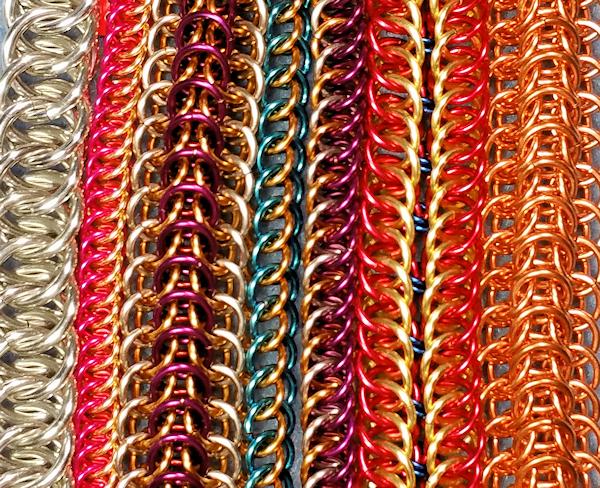
Half Persian 3in1, 4in1 and DragonBack Tutorial
I know that HP has the reputation of being difficult, but it really isn’t — at least not without a little help in the very beginning (which of course I provide). Then like most weaves, once you have the rhythm, it’s not all that hard at all! There are lots of very detailed photos to show you what ring goes where.
(Note to anyone reading this post on Google Translate — this ebook is written in English.)
What’s in the Tutorial?
We’ll start out with the easiest of the weaves — the HP3in1. With a couple of tips in the very beginning on how to start the weave, it becomes a whole lot easier!
Once you have the hang of that weave, time to move onto the HP 4in1. This is a beautiful, very dense weave. Once again I provide two different ways to start out the weave to make things that much easier!
Do you want to double your fun? How about a doubled HP 4in1! It’s actually pretty easy, and it’s reversible in a way that can give you two different looks.
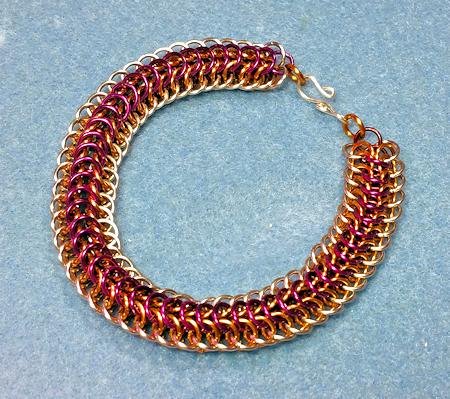
              DragonBack Bracelet
We’ll finish up with DragonBack, which is a weave that is rather unusual and not often seen. It, too, is a dense weave, and it makes a very substantial piece of jewelry. Not to mention an absolutely gorgeous one! But please note — DragonBack and the more commonly-seen DragonScale are not the same weave. In this ebook I teach you DragonBack.
With these weaves, I demonstrate each weave in at least two different color rings, so you can more easily see how the weave is put together. I also show some common mistakes, how to recognize them quickly and how to fix them.
There’s lots in the ebook. It’s 37 pages and has 79 photos, so you have a lot of instructions and plenty of close-ups. The photo at the top of the page shows all the weaves you’ll find in this ebook tutorial. This ebook is in PDF form, and is just a little over 1.6 MB in size.
Purchase the Tutorial
The ebook is just $6, which is a small amount for everything you get, especially with the super-close-up photos — which many times I show multiple angles so you are sure where to put that next ring!
You can buy the ebook securely through the link below. All major credit cards are accepted. Just as an FYI, it does go through the PayPal interface. You will get a link for an immediate download — and then you’re on your way!
Thanks so much for reading this far, and happy maille-ing!
Quick Guide to Czech Bead Shapes – Two Hole Beads
Two hole beads have come a long way since I bought my first tube of SuperDuo beads. Now when it comes to “playtime”, we have all kinds of options. You can use them by themselves, or along with your favorite seed or other beads. Want even more fun? Mix different sizes and shapes!
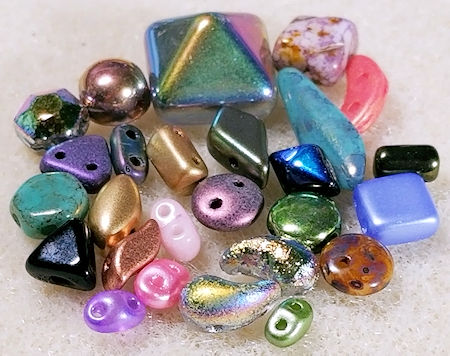
Just a Few Two Hole Czech Beads
When shopping for these beads, you’ll typically see them as “Czech seed beads” or “Czech beads” or “CzechMates”.  Supposedly the sizes of the CzechMates are more standardized, so they work well together — they used to be just 6mm on the longest side. However, there are other sizes in the CzechMate family now, so the lines are getting blurred.
I was originally making this one large post, but then I realized how very long it was! So, I am splitting this into three posts — two holes, one hole and three of more holes. (I’ll link them as soon as I have the other posts up.)
This post will be about the various two-hole shapes that are out there, with their sizes. I’ll list them in alphabetic order.
- Amos par Puca: These are pear-shaped beads, with the two holes running through the sides. 5mm x 8mm.
- Arcos par Puca: Three holes, these are crescent-shaped, with the holes running along the side of the bead. Size is 5mm x 10mm.
- Bar: Two holes, these are typically used as a spacer. The beads resemble a flattened oval, with the holes running horizontally. Size is 2mm x 6mm.
- Baroque Cabochon: Two holes. This is a cabochon shape, but the curved top has a baroque pearl kine of look. The two holes are parallel through the bottom. 7mm diameter at the bottom.
- Bi-Bo: These are similar to SuperDuo beads, but the centers are concave instead of convex. Approximately 5.5mm x 3mm in size.
- Brick: Similar to Bar beads, but these are more rectangular. The size is 3mm x 5mm.
- Cabochon: Two holes. These beads have flat backs and a domed top. They kind of remind me of gumdrops! 4.5mm x 6mm. I’ve also seen them in a 7mm diameter.
- Carrier: Two holes. New to the market (at the time of this writing), they are much larger than the standard two-hole beads. They are more pillow-shaped — thinner on the ends, thicker across the middle. Intriguing, as I’ve yet to buy and try them. They are 9mm x 17mm.
- Crescent: Two holes. Similar to Arcos par Puca, but the holes are on the face of the bead, instead of through the side. 2mm x 10mm in size.
- Dagger: Two holes or one hole, these are very much like regular dagger beads. 5mm x 16mm.
- DiamondDuo: Two hole beads, these are diamond-shaped. One side is flat, and the other is lightly faceted.  5mm x 8mm.
- DiscDuo: Two holes. These are flat lentil-ish, bit with the holes through the narrower side of the bead. Approximately 4mm x 6mm.
- GemDuo: Very much like the DiamondDuo, but the side that isn’t flat has more of a rounded profile, as opposed to faceted. Approximately 8mm x 5mm.
- Half Moon: Similar to the Crescent beads, but instead of having a curve on both sides, the curve is on one side, while the other is flat. They are also a bit smaller in size. The holes are on the face of the bead. 4mm x 8mm.
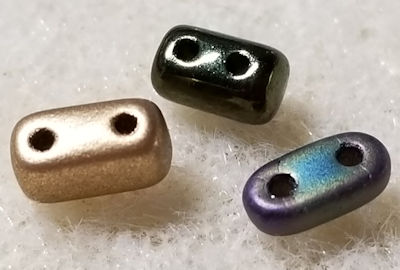
Bar, Brick and Rulla
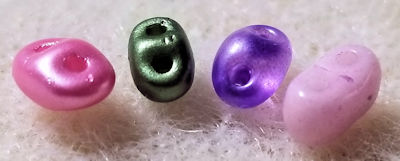
SuperDuo, MiniDuo, Twin and Bi-Bo
- HoneyComb: These beads have the two holes runningthrough the narrower side of the bead. Both the top and bottom are flat. And of course, they are six-sided and look like a honeycomb! 3mm x 6mm.
- HoneyComb Jewel: The same as the regular two-hole HoneyComb, but these are faceted on one side. Roughly 4mm x 6mm in size (the facets make it a little bit thicker).
- Ios par Puca: Very similar to the Bar beads, they also have a rounded top and bottom, but with straight sides. Size is 2.5mm x 5.5mm.
- IrisDuo: Two holes. These are a smooth marquise in shape, and the holes are parallel through the sides. 4mm x 7mm.
- Kite: Two holes. Similar to the DiamondDuo, but these have more of a kite shape than a diamond shape. 5mm x 9mm.
- Kheops par Puca: Interesting triangle bead. Two holes, which run vertically from base to tip. Both top and bottom are flat. Size is 3mm x 6mm.
- Lentil: Two holes. These have a puffed disc shape, and the holes are on the flatter sides. Size is 3mm x 6mm.
- MiniDuo: Two holes, these are like SuperDuos, just a little smaller. Same shape, but the size is 2mm x 4mm.
- Nib-Bit: Two holes. These remind me of flattened gumdrops on steroids, LOL. Think of them as a very tall cabochon, but instead of the holes being at the bottom of the bead, they are parallel through the sides. 5mm x 6mm.
- PaisleyDuo: These are paisley-shaped as you might imagine. The top and bottom are flat, and the holes run parallel though the sides. Because the top and bottom are flat, they can be used as both right facing and left-facing (i.e., which direction the tail points). 5mm x 8mm.
- Piggy: Lentil beads, but instead of the holes being even spaced on either side, one is in the center and the other is off to the side. They are also slightly larger, with a size of 4mm x 8mm.
- Pyramid: Think of these as a pyramid, except instead of having only 6 facets, these have 6 facets. The holes are parallel through the bottom. 12mm.
- RounDuo: Two holes with a slightly off-round shape (which you may not really notice unless you put them next to some really round beads, like glass pearls). Size is 5mm.
- Rulla: Two holes, these are like Bar beads, but rounded on the front and back. The sides that have the holes (which run horizontally) are flattened. Size is 3mm x 5mm.
- Silky: These are two hole tile-shaped beads, flat on one side and with a “puff” on the other. The holes on this bead run diagonally. 4mm x 6mm.
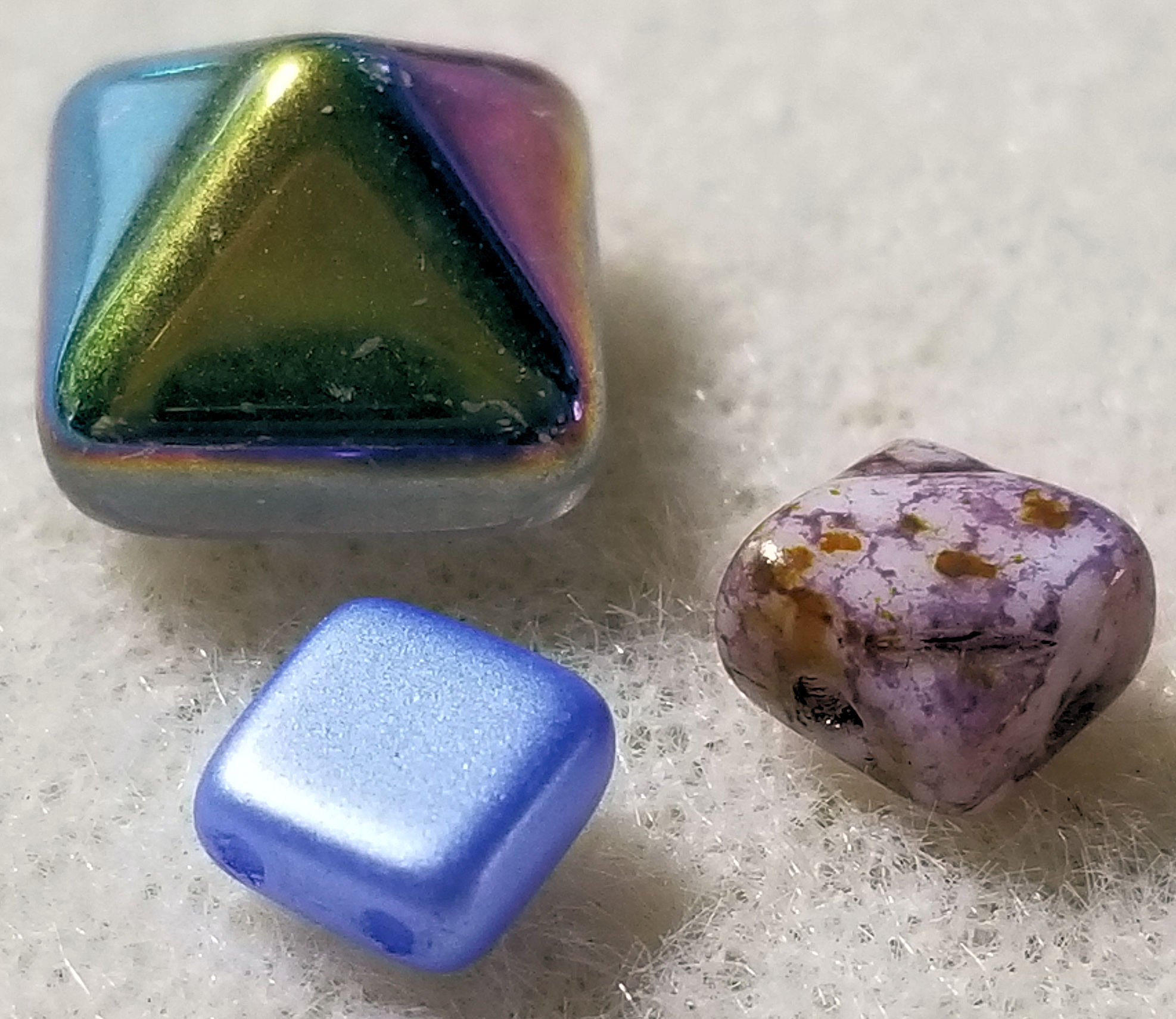
Stud (Pyramid), Silky and Tile
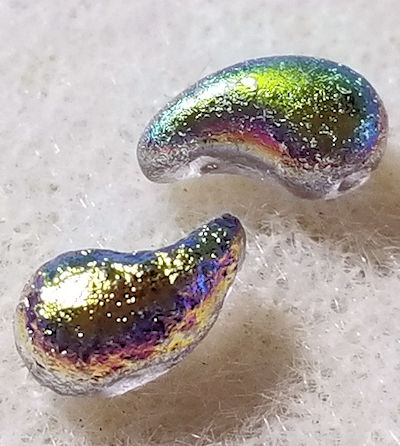
ZoliDuo Beads, Left and Right
- Stud: Two holes, with one flat side and the other with four facets, meeting up to a gently rounded point. I’ve seen these in both 6mm and 8.5mm x 12mm sizes, but the 12mm size is most common.
- SuperDuo: Two-holes, these are probably the best known and most popular of the two hole beads. Somewhat of a tapered oval, gently rounded with a slight “pinch” in the center. 2mm x 5mm.
- Super Kheops par Puca: These are the regular Kheops par Puca, but closer to a pyramid-type bead. 6mm.
- Tile: These are flat square beads, with the two holes running horizontally. Size is 3mm x 6mm.
- Triangle: Two holes. These are flat, thin beads, with the holes at the bottom.  2mm x 6mm.
- Twin: Two holes. Very much like the SuperDuo, but a little more rounded and every so slightly thicker. 2.5mm x 5mm. It’s easy to mistake these for SuperDuos.
- ZoliDuos: These are paisley-shaped, like the PaisleyDuos. The difference is that the ZoliDuos have one side that’s flat and one that is rounded.  In any case, because both sides are’t flat, they come in both a right side and a left side — there is definitely a difference in the way the tail points, so when you buy these, make sure to get both left and right versions. 5mm x 8mm.
These are the ones that either I have, or at least have seen at the time of this writing. There are even more out there, because new ones seem to pop up each day. And I have undoubtedly missed some on this list!
Interested in how to use these beads in projects? Check out my Youtube playlist for two-hole beads!

